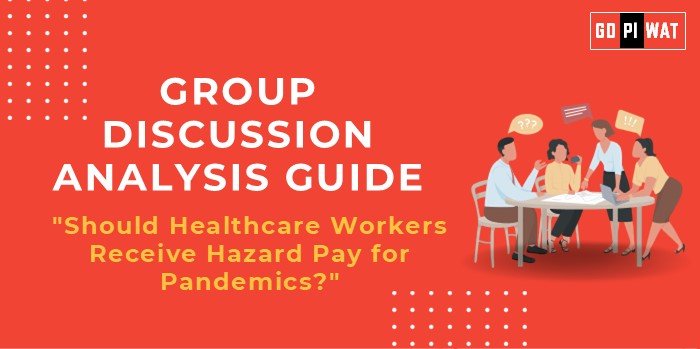📋 Group Discussion Analysis Guide on “Should Healthcare Workers Receive Hazard Pay for Pandemics?”
🌐 Introduction to Hazard Pay for Healthcare Workers during Pandemics
Opening Context: Pandemics, such as COVID-19, highlight the critical role of healthcare workers, who face significant risks on the front lines. As demand for their services surges, questions arise about appropriate compensation, specifically whether hazard pay is warranted.
Topic Background: Hazard pay, a supplemental wage for those working in dangerous conditions, gained attention during COVID-19, where healthcare workers faced prolonged exposure to health risks. This topic is relevant as it addresses ethical, economic, and policy issues around fair compensation.
📊 Quick Facts and Key Statistics
🦠 Infection Rates: During the peak of COVID-19, healthcare workers accounted for about 14% of cases globally (WHO), highlighting their elevated risk.
💭 Mental Health Impact: Studies show 60% of healthcare workers reported burnout during the pandemic, driving the need for enhanced support.
💰 Economic Strain: The pandemic added $200 billion in labor-related expenses for healthcare systems globally, making hazard pay a challenging yet significant expense.
📄 Existing Hazard Pay Models: Countries like the U.S. implemented temporary hazard pay structures during COVID-19, offering a precedent for future policy considerations.
🤝 Stakeholders and Their Roles
- 🏛️ Government Bodies: Regulate healthcare pay policies, provide emergency funds, and allocate resources for hazard pay.
- 🏥 Healthcare Institutions: Administer payroll, manage budgeting for staff support, and advocate for worker safety and fair compensation.
- 📢 Healthcare Workers’ Unions: Push for hazard pay policies, safeguard workers’ rights, and negotiate with institutions on behalf of workers.
- 👨👩👦👦 Patients and Families: Indirect stakeholders as hazard pay policies can impact the retention and well-being of healthcare workers.
🏆 Achievements and Challenges
✨ Achievements:
- 💵 Financial Support during COVID-19: Many governments introduced temporary hazard pay, recognizing healthcare workers’ critical roles.
- 📣 Increased Public Awareness: The pandemic raised awareness of the need for fair compensation for healthcare workers.
- 🏢 Institutional Changes: Some healthcare facilities introduced long-term policies for employee well-being and financial support.
⚠️ Challenges:
- 💸 Budget Constraints: Hazard pay increases financial strain on healthcare systems, especially during prolonged health crises.
- 📊 Lack of Standardization: Hazard pay policies vary widely by region, creating inconsistencies and potential inequities.
- 🌍 Global Comparisons: The U.S., Canada, and parts of Europe implemented varied hazard pay structures, while many developing nations faced financial and logistical barriers to similar measures.
🗣️ Structured Arguments for Discussion
Supporting Stance: “Hazard pay is essential to recognize healthcare workers’ sacrifices and compensate for the increased risks and demands placed upon them during pandemics.”
Opposing Stance: “The additional costs of hazard pay could strain healthcare budgets, leading to cuts in other critical services or long-term financial instability.”
Balanced Perspective: “While hazard pay is justified, it should be implemented with sustainable funding solutions to avoid compromising healthcare system resilience.”
💡 Effective Discussion Approaches
- 📊 Opening Approaches:
- Statistics Highlight: “With 14% of COVID-19 cases involving healthcare workers, the risks they face underscore the need for hazard pay.”
- Contrast Approach: “In nations like the U.S., healthcare workers received hazard pay, while in others, financial constraints prevented similar measures.”
- 🛠️ Counter-Argument Handling: Emphasize the need for sustainable funding sources or a phased hazard pay model to address budget concerns without compromising healthcare.
📈 Strategic Analysis of Strengths and Weaknesses
- Strengths: Recognizes healthcare workers’ contributions, promotes morale, attracts talent to the field.
- Weaknesses: Financially burdensome, inconsistent implementation, potential for dependence on temporary solutions.
- Opportunities: Establish standardized global hazard pay policies, improve healthcare workforce retention.
- Threats: Prolonged financial strain, potential reduction in patient services, budget cuts.
🎓 Connecting with B-School Applications
- 📚 Real-World Applications: Relevant to B-school topics in human resources, healthcare management, and policy analysis.
- 💬 Sample Interview Questions:
- “How would you implement a sustainable hazard pay model for healthcare workers?”
- “Discuss the economic and ethical implications of hazard pay in healthcare.”
- 🔑 Insights for B-School Students: Highlight the importance of sustainable HR practices, healthcare budgeting, and ethical leadership in crisis situations.


